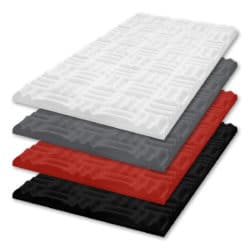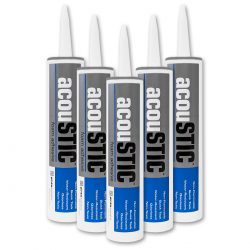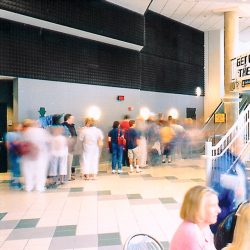Foot Locker
The Issue
Foot Locker has turned hundreds of its stores into cutting-edge sight and sound arenas. They are complete with 24 screen video walls, synchronized light shows and surround sound systems. The only problem was that with so much sound in one space, the reverberation echo created havoc in the stores.
The Challenge
Each arena was given the theatrical look and feel of urban back-street basketball courts and other sports venues. Then, four times every half hour, the store lights dim and a rotating set of show-stopping, two-minute sight and sound videos begin, promoting an active lifestyle. Part of the fun is that one can hear as well as see all of the action. Unless, of course, there’s so much reverberation within the store that it is impossible to tell where any sound originates. Then instead of fun and excitement, there is just indistinguishable noise.
That was the challenge facing the Foot Locker store design team: to recreate that excitement, flawlessly and cost-effectively, in hundreds of different Foot Locker outlets across the United States and Canada. But every design element that helps create excitement also creates serious acoustic problems.
“We needed to deaden the sound of the arena show”, said Joel Torielli of WJCA Project Planners and Designers of New Jersey. “Without some sort of sound attenuation, the space was just too lively.” The goal was to create a theatrical experience without using any of the traditional solutions that a movie theater relies on. None of the sound-absorbing approaches used in a theater, such as curtains, carpets, padded seating or acoustical ceiling tiles would fit in with the new Foot Locker look.
To really understand how tough a challenge the designers faced, we need to take a closer look at the Foot Locker sight and sound arena. Surrounding the customer with wood, metal and glass paneled walls, painted concrete floors and an open ceiling that exposes duct, beams and wiring creates an urban, edgy effect. All very cutting-edge and all made of sound reflective surfaces, causing serious reverberation.
Why is Reverberation a Problem?
When sounds have lots of hard surfaces to bounce off, they hang in the air longer. If one sound can still be heard when the next sound arrives, each becomes more difficult to distinguish. The end result of too many sounds clashing is an echo-chamber-like blur. A listener cannot tell one sound from another or where the sound is coming from. The “high tech” look of the arena’s exposed ceiling posed yet another acoustic challenge. Those ducts and pipes don’t just reflect sounds, they create them. The HVAC duct-work provides a year-round “whoosh” of sound that cuts in and out at the most inappropriate times—say, during a dramatic pause in the video soundtrack.
An additional challenge was that the stores are all different sizes and shapes. The prototype arena may well have offered the toughest acoustic environment. Boston’s Arsenal Mall is a brick structure. As its name implies, it originally housed a weapons manufacturing plant and was used for munitions testing. It’s brick walls, concrete floors and high open ceilings may have been the ideal setting for an athletic store. However, it is also an acoustic nightmare for a state-of-the-art sound experience.
The Solution
The solution took shape, literally, in the form of acoustic panels. To maintain the arena look, the team choose the Sonex® One Acoustic Foam panels and installed them high on the walls above normal ceiling height. “The high ceilings were part of the unfinished look that we wanted, but the extra height added to the reverberation problem”, said Torielli. “Covering the perimeter with the foam controlled the noise problem. And the pattern of the panels fit right in with the edgy look and feel of the arena setting.”
The Result
Many of the other stores quickly followed the Arsenal Mall store. Almost none posed quite as tough an acoustic challenge as the prototype store, which made for an interesting irony. Though the other stores didn’t need as many panels to get the desired acoustical effect, the panel’s high-tech look had become a key element of the overall image of the stores. The designer opted to keep the full complement of panels in all of the other store arenas. The result is a uniform store design that draws customers to the excitement without driving them away because of the noise.
To learn more about how Acoustical Solutions can solve your noise control problems, use our contact form, call one of our Acoustical Sales Consultants at (800) 782-5742, or visit us on the web at acousticalsolutions.com.











